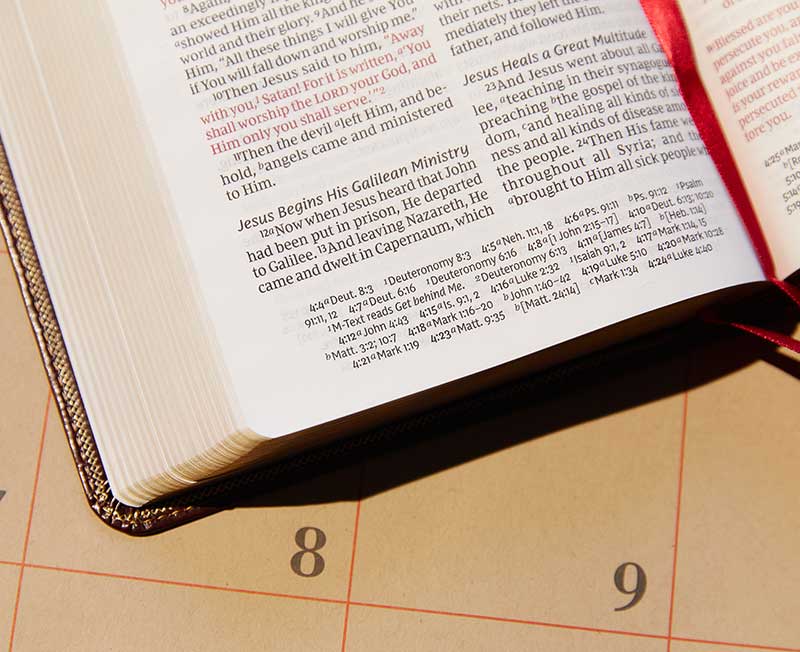Cross-references are some of the most popular research tools for Bible study. They link Scriptures of the same theme together, making them good tools for personal study, sermon preparation, research for classwork, and lots more. They’re readily available and they’re easy to use. In this article, we’ll look at some tips for using Bible references to help you get the most out of your Bible study.
1. Use Cross-References as a Research Tool
When you have a question about a person, place, or event in the Bible, you’ll often find the information you need in another passage of Scripture. Cross–references allow Scripture to interpret Scripture. They can shed light on the passages you’re studying and provide more information and different details about people, places, events, etc.
2. Understand the Different Types of Cross-References
Recognizing the types of cross-references will help you with Bible study and interpretation. Cross–references can link to specific words, phrases, parallel passages, quotes, similar ideas, comparisons, events, prophecies, and more. This can show a relationship between thoughts, cause and effect, contrast, etc.
3. Understand How Cross-References are Written
Knowing how the cross–references are written in the text and the reference area will help you to know which references apply to which portion of Scripture.
Small letters are used for cross-reference indicators and are placed on the text that a set of references apply to. In the list of cross–references, you’ll see the chapter and verse number that a set of references correspond to. They include the letter that links the reference to a portion of the verse.
The list of references will provide just the verse number for those in the same chapter, the chapter and verse numbers for those in the same book, and the book name with chapter and verse numbers for references outside of that book of the Bible.
4. Read the Context
Rather than reading just the verse or the portion of the verse that the reference links to, read before and after the verse to see the complete theme. Usually, the cross–references that will give you the closest context to the passage you’re reading will be found in the book you’re reading. Next would be books by the same author, and then those written around the same time or in the same genre.
All of the questions you need to ask about context still apply: who is the author, who are they writing to, what is the occasion of writing, what are the surrounding events, etc. Ask these questions about the passage you’re reading as well as the references they link to.
5. Look up the References of the References
Each verse has a list of references and each verse in that list has a list of references. Once you’ve followed the references for the verse you’re studying and identified which are the most useful for what you’re studying, follow the references that each of those references provide.
6. Keeping your Place
When turning to the various references it can sometimes be difficult to keep the place you started from. Bibles with multiple ribbon markers make it easy to return to the original verse as well as a few others that you want to revisit. Alternately, you could take a picture of the references with your smartphone or use a second Bible to read the verses.
7. Make a List of References You’ve Read
Cross-references are placed on multiple verses throughout the text. Many of these verses will reference many others and some link to the same verses. Pay attention to the number of times the same reference appears. This often reveals a prominent reference for a specific theme.
Creating a list of the verses you’ve already read will keep you from reading the same verses multiple times and it will help to keep your list organized. This list will also help in study and sermon preparation. In your list, summarize each verse to aid in study and meditation. Use your list to review and meditate on the passage and context.
8. Write Down or Mark the Most Relevant References
Identifying the most relevant references helps you to make your own connections. This is especially helpful if you’re making notes in a journal. You’ll be able to refer back to your notes and see which references you needed the most.
9. Highlight Your Favorite References
Use a Bible highlighter or a pen to mark your favorite or the most relevant references in the margins. You could use color to identify the types of references, topics, or something that matters to you.
10. Add Your Own
Reference Bibles can’t include every possible reference for every verse. Many connections have already been made in reference Bibles, but there’s always more that can be made. Going from one reference to another might reveal one that you’d like to see added to other verses. If you see a verse that fits, but the reference isn’t there, add it yourself.
Conclusion
Cross-references are one of the best tools for study because they allow the Bible to interpret itself. They’re not difficult to use, and when used correctly they can enhance your study and sermon preparation. The tips in this list can help you dig deeper into God’s Word and make your Bible study time as productive as possible.
To find your perfect reference Bible, be sure to browse Thomas Nelson Reference Bibles.






3 replies on “10 Tips for Using Bible Cross References”
Need to know more how to use references for Bible study
I am saved JESUS IS LORD AND SAVIOUR. MAY THE ALMIGHTY GOD KEEP YOU AND BLESS YOU.
King James study Bible